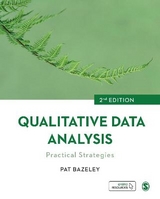
Qualitative Data Analysis
SAGE Publications Ltd (Verlag)
978-1-84920-303-6 (ISBN)
- Titel erscheint in neuer Auflage
- Artikel merken
Written by an experienced researcher in the field of qualitative methods, this dynamic new book provides a definitive introduction to analysing qualitative data.
It is a clear, accessible and practical guide to each stage of the process, including:
- Designing and managing qualitative data for analysis
- Working with data through interpretive, comparative, pattern and relational analyses
- Developing explanatory theory and coherent conclusions, based on qualitative data.
The book pairs theoretical discussion with practical advice using a host of examples from diverse projects across the social sciences. It describes data analysis strategies in actionable steps and helpfully links to the use of computer software where relevant.
This is an exciting new addition to the literature on qualitative data analysis and a must-read for anyone who has collected, or is preparing to collect, their own data.
Pat Bazeley is Director of Research Support P/L and Adjunct Professor in the Translational Research and Social Innovation Centre at Western Sydney University. Since graduating in psychology, she has worked in community development, as an evaluation researcher, and in academic research development. For almost 30 years Pat has been providing research training and project consulting to academics, graduate students and practitioners representing a wide range of disciplines across Australia and internationally. Her particular expertise is in helping researchers to make sense of qualitative, survey, and mixed methods data, and to use computer programs for management and analysis of data. Pat’s research has focused on qualitative and mixed methods data analysis, the development and performance of researchers, and the wellbeing of older women. She has published books, chapters, and articles on mixed methods and qualitative data analysis. She serves on the Editorial Board of the Journal of Mixed Methods Research and was 2015–2016 President of the Mixed Methods International Research Association.
PART ONE: PREPARING THE WAY: LAYING THE FOUNDATIONS FOR ANALYSIS
Foundations for Thinking and Working Qualitatively
Thinking Qualitatively
Thinking Methods (and methodology)
Working Qualitatively
Working Qualitatively - Using Software
Foundations for Working Qualitatively
Working Qualitatively: Implications for Analysis
Writing About Foundations
Exercises
Further Reading
Designing for Analysis
Design-giving Form to Ideas
Focusing the Study
Designing for Data That Can Be Analysed
Planning for Quality and Credibility of Conclusions
Putting It All Together
Writing About Design
Exercises
Further reading
Managing and Preparing Data for Analysis
Before Data Collection
Keeping Organised, Available and Usable Data Records
Recording and Preparing Data for Analysis
The Importance of Context
Recording Sample Details for Analysis
Checks and Balances for Data
Managing Relationships in the Research Team
Writing About Data Management
Exercises
PART TWO: WORKING WITH DATA: A PATHWAY INTO ANALYSIS
Read, Reflect and Connect: Initial Explorations of Data
Read, and Read Again
Write As You Read
Purposeful Play-preliminary Explorations of Each Data Source
Explore the Storylines
Exploring Context
Identify Relevant Categories and Concepts
Involving Participants in Early Analysis
Re-focus, Ready For the Next Phase
Writing About Preliminary Analysis
Exercises
Further reading
Codes and Coding: Principles and Practice
Using Codes to Work With Data
Practical Tools for Coding
Methods Decisions in Coding
Issues of Validity and Reliability in Coding
Managing the Process of Coding
A Final Reminder - Codes and Coding in Context
Writing About Coding Processes
Exercise
Further reading
Naming, Organizing and Refining Codes
What′s in a Name?
Naming Broad Topic Areas
Naming Codes to Capture Substance and Meaning
Automating Coding
Developing a Coding System
Reviewing and Refining Codes and the Coding Structure
Writing About Codes
Exercise - Generating Codes
Further Reading
Alternative Approaches to Breaking Open and Connecting Data
Building on Cases
Themes as an Alternative to Codes?
Focus on Interaction - Working With Focus Group Data
Focus on Stories and Accounts - Identifying Structure, Interpreting Meaning
Focus on Discourse - The Intersubjective Space
The Value of Case-based Approaches
Writing About Your Use of Case-based, Thematic and Narrative Methods
Exercises
Further Reading
PART THREE: DESCRIBE, COMPARE AND RELATE: MOVING ON FROM CODES AND THEMES
Describing, Evolving and Theorizing Concepts
Describing Categories and Concepts (or themes) as a Step in Analysis
Evolving Concepts with Analytic, Meta- or Pattern Codes
Theorising Concepts
Writing About Describing and Analysing Concepts
Exercises
Further Reading
Comparative Analyses as a Means of Furthering Analysis
Why Compare?
The Comparative Process
Managing Data to Make Subgroup, Contextual or Case Comparisons
Comparing Concepts or Categories Across Groups or Situations
Comparing Cases
Interpreting Comparative Analyses
Writing About Comparisons
Exercises
Further Reading
Relational Analyses
Coding and Connecting Working Together
Investigating Relational Patterns
Cross-case Analyses
Identifying Patterns of Association Between Sets of Related Phenomena, Using Coded Data
Relating Data to a Theoretical Model
Investigating Relationships Between Specific Categories and Concepts
Writing About Exploring and Testing Relationships in Data
Exercises
Further Reading
PART FOUR: BRINGING IT TOGETHER - MOVING TOWARD CLIMAX AND CLOSURE
If… Then… Is It Because? Developing Explanatory Models and Theories
Analytic Progression
Explanatory Theory as a Goal of Research
Foundations for Explanatory Theory
Logic-based Questioning - Finding the Major Premise
Puzzle-solving with "Conjectures and Refutations"
Case-based Strategies
Theoretical Development and Integration in Grounded Theory
Visual Tools for Theory-Building
Writing About Your Developing Theory
Further Reading
Developing Coherent Understanding
Coherent Understanding?
Coherence Through Description
Theoretical Coherence
Coherence Through Display
A Collection of Tips and Tricks for Bringing it Together
Writing About Developing Coherence
Further Reading
Defending and Extending: Issues of Quality and Significance
The Issue of Quality
Generalisation / Transferability
Theoretical Extension
Audiences and Representation
A Final Reflection
Writing About Quality and Significance
Exercises
Further Reading
After-Words
| Erscheint lt. Verlag | 18.2.2013 |
|---|---|
| Verlagsort | London |
| Sprache | englisch |
| Maße | 186 x 232 mm |
| Gewicht | 840 g |
| ISBN-10 | 1-84920-303-2 / 1849203032 |
| ISBN-13 | 978-1-84920-303-6 / 9781849203036 |
| Zustand | Neuware |
| Haben Sie eine Frage zum Produkt? |
